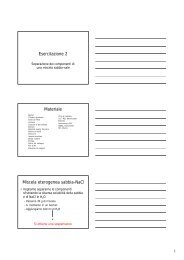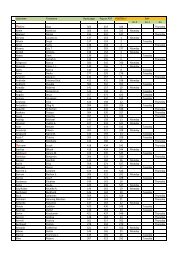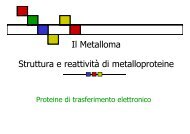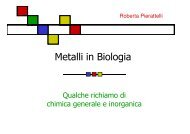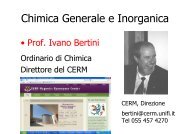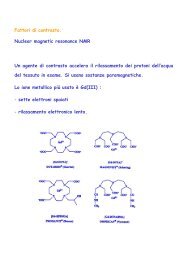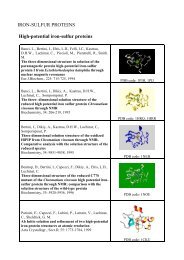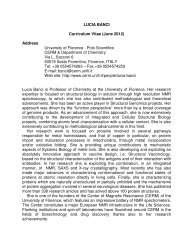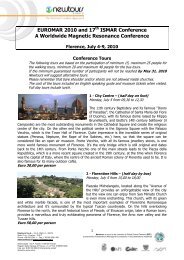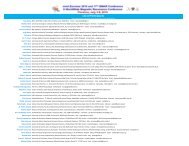(Microsoft PowerPoint - Lezione_2.ppt [modalit\340 ... - CERM
(Microsoft PowerPoint - Lezione_2.ppt [modalit\340 ... - CERM
(Microsoft PowerPoint - Lezione_2.ppt [modalit\340 ... - CERM
Create successful ePaper yourself
Turn your PDF publications into a flip-book with our unique Google optimized e-Paper software.
(Il Metalloma)Struttura e reattività dimetalloproteinecorso integrato con “Laboratorio di espressione dimetalloproteine”
Elements of biological relevance1 2 3 4 5 6 7 8 9 10 11 12 13 14 15 16 17 18HHeLi Be B C N O F NeNa Mg Al Si P S Cl ArK Ca Sc Ti V Cr Mn Fe Co Ni Cu Zn Ga Ge As Se Br KrRb Sr Y Zr Nb Mo Tc Ru Rh Pd Ag Cd In Sn Sb Te I XeCs Ba Ln Hf Ta W Re Os Ir Pt Au Hg Tl Pb Bi Po At RnFr Ra Ac Th Pa UBulk biological elementsTrace elements believed to be essential for bacteria, plants or animalsPossibly essential trace elements for some speciesTOXICBENEFICIAL
Elements present in the human body (grams/70kg)Bulk:O (42’000), C (16’000), H (7’000), N (1’800), P (800), S (140), Cl (84)Bulk metallic:Ca (1’100), K (140), Na (100), Mg (20)Trace:Fe (4.2), F (2.6), Zn (2.3), Si (1), Cu (0.072), I (0.02), Sn (0.02),Se (0.015), Ni (0.015), Cr (0.014), Mn (0.012), Mo(0.005), Co(0.003)Ultratrace:Al, As, B, Br, Cd, Ge, Li, Pb, Rb, VParis I, Bentos Jones Jr, 2000. The hand book of trace elements, St. Lucie PressFrausto da Silva JJR, Williams RJP, 2001. The biological chemistry of the elements, Oxford University Press
ElementCaCoCuFeMgMnMoNiKRbSeNaSrWVZnRoleStructure stabilization - Signaling - Enzyme activatorRedox catalystET - Redox catalyst - O 2 carrierET - Redox catalyst - O 2 carrierEnzyme activator – DNA structure stabilization - RibozymesRedox catalist – Activator of hydrolases, ligases andtransferasesRedox catalyst (nitrogenase, oxotransferases)Hydrolitic activity – Redox catalistATPases pumping - Structure stabilization – Electrostatic effects on redoxpotential of distant centersFunction similar to that of K in some plantsRedox catalystATPases pumping - Structure stabilization – Electrostatic effects on redoxpotential of distant centersFuntion similar to that of Ca in some plantsReplaces Mo in some hyperthermophilic archeaPeroxidase and nitrogenase activity in some algae and fungiHydrolitic activity – Structure stabilization – Transcription factor
Metal-MACiEA database on the properties and functions ofmetal ions involved in enzyme catalysisMACiE=MechanismAnnotationandClassificationinEnzymes
Metal-MACiE statisticsAbout 40% of enzymes with known structure requires(at least) a metal ion to perform its reaction mechanismAll enzymesEnzymes with known structureMetalloenzymes with known structure
Metal-MACiE statistics13 different metal ions are involved in catalysis
Bioinorganic chemistry in asystem-wide perspectiverequires comprehensive datasets similar to those producedby genomics, proteomics, etceg requires the determination ofmetalloproteomes
High-throughput experimentaltechniques for theidentification ofmetalloproteins on a genomescale are not yet available
Bioinformatics can be used toidentify metalloproteins basedon protein sequencePrediction ofApplication tocomplete proteomesmetalloproteomes
How do we identifymetalloproteins ingene banks?(http://www.ncbi.nlm.nih.gov/RefSeq)
We need to define the MetalBinding Patterns (MBP), eg asfound from the PDBeg, HxxHxxxChttp://www.pdb.org/pdb/home/home.do
The answer is:If a sequence in a Gene Bankcontains a Metal BindingPattern (MBP) equal to one inthe PDBand there is similarity aroundthe metal binding ligands,then the protein is proposedto be a metalloprotein
How many metalloproteins are inthe human genome?Bioinformatics tells us:Zinc - ca. 3800Copper - ca. 80Non-heme iron- ca. 250Andreini, Banci, Bertini and RosatoJ.Proteome Res. 2005, 2006, 2008, Proteins 2007
Functional classification of allputative human zincproteinsHuman Zn-proteome (3745 sequences)Translation1%Transferase8%Transport4%Transcription44%Unknow n1%Zn-finger1%Structural1% Signal7%Hydrolase19%Ligase12%Lyase1%Oxidoreductase1%DNA-replicationHydrolaseIsomeraseLigaseLyaseOxidoreductaseProtein-Ubiquitin-bindingSignalStorage-HomeostasisStructuralTranscriptionTransferaseTranslationTransportUnknownZn-fingerDecaria L. Rosato A. Bertini I., jbic, 2010
Functional roles of zinc-binding proteins in theBacteriaBacteria Zn-proteomes - 6250 sequencesTranscription6%Structural1%Signal2%Transferase10%Oxidoreductase6%Lyase6%Transport5%Ligase5%Unknow n1%DNA-replication4%Isomerase4%Hydrolase50%three domainsArchaeaDNA-replicationHydrolaseIsomeraseLigaseLyaseOxidoreductaseProtein-Ubiquitin-bindingSignalStorage-HomeostasisStructuralTranscriptionTransferaseTranslationTransportUnknownZn-fingerEukaryotaZinc has a crucial role inregulating gene expressionArchea Zn-proteomes - 1607 sequencesTranslation5%Transferase14%Transcription11%Structural5%Eukarya Zn-proteomes - 10479 sequencesTranslation1%Transferase7%Transcription37%Transport4%Transport3%Signal1%Oxidoreductase3%Structural1%Unknow n1%Unknow n3%Lyase4%Signal8%DNA-replication2%Zn-finger1%Ligase6%Hydrolase44%Isomerase1%DNA-replication1%Hydrolase21%Ligase13%Lyase1%Oxidoreductase2%DNA-replicationHydrolaseIsomeraseLigaseLyaseOxidoreductaseProtein-Ubiquitin-bindingSignalStorage-HomeostasisStructuralTranscriptionTransferaseTranslationTransportUnknownZn-fingerDNA-replicationHydrolaseIsomeraseLigaseLyaseOxidoreductaseProtein-Ubiquitin-bindingSignalStorage-HomeostasisStructuralTranscriptionTransferaseTranslationTransportUnknownZn-finger
The Cu-binding proteinsEukaryota (0.3% ± 0.2%)Archaea (0.4% ± 0.3%)Bacteria (0.3% ± 0.2%)UnknownTranscriptionHomeostasisoxidoreductasee - transferAndreini, Banci, Bertini, Rosato, 2007
BacteriaArchaeaEukaryotaArchaeal proteomescontain therelatively largestfraction of ironproteins.HumanAll the threedomains of life havethe same ancestralrepertoire ofnon-heme ironproteins.
Metalloprotein share of the proteome in1086420the three domains of LifeFe Zn CuBacteria1086420FeFe = non- heme iron proteinsZn1086420CuFeArchaeaZnCuEukaryota
Predicted metalloproteomesprovide the basis forcomparative analyses of metalmanagement and usageacross organisms
Usage of copperin living organismsOut of 57 representative organisms spanning the entire tree of life:7 (12%) do not have any copper-binding proteinNanoarchaeum equitans, Mesoplasma florum, Onion yellows phytoplasma, Chlamydia trachomatis,Borrelia burgdorferi, Methanocaldococcus jannaschii, Methanopyrus kandleri12 (21%) have only a basic copper efflux system: they do not need copper tosurvive, but are able to remove it from the cellArchaeoglobus fulgidus, Thermoplasma acidophilum, Thermotoga maritima, Streptococcus pyogenes,Thermoanaerobacter tengcongensis, Chlorobium tepidum, Pyrococcus abyssi, Methanothermobacterthermoautotrophicus, Bifidobacterium longum, Fusobacterium nucleatum, Bacteroides thetaiotaomicron,Desulfotalea psychrophilaTherefore, 1/3 of organisms do not need copper for their metabolism(typically host-associated, or adapted to extreme environments, and 14 out of19 (74%) anaerobes)
Human copper-proteome82 copper-proteins:39 involved in homeostasis/trafficking:Sco1;Sco2;ATP7A;ATP7B;5 CutA;CTR1;CTR2;HAH1;COX11;2 CCS;COX17; 4 ATPase-like; cutChomolog; 17 Metallothioneins ; COX1935 enzymes:Ceruloplasmin; Tyrosinase; Tyrosinase related protein 1; Dopamine beta hydroxylase; 4Peptidylglycine alpha amidating monooxygenases; 2 Monooxygenases; Amiloride bindingprotein 1; 2 Retina-specific copper amine oxidases; Dopachrome tautomerase; SOD1;SOD3; Amine oxidase; COXI; COXII; 2 Hephaestins; 2 Hephaestin-like; 2 Ceruloplasmin-like;NADH-ubiquinone oxidoreductase; Indoleamine 2,3-dioxygenase; Lysyl oxidase ; 6 Lysyloxidase-like ;Indoleamine-pyrrole 2,3 dioxygenase-like8 Under study (unknown function)Tenomodulin, 7 hypothetical proteinsAndreini, Banci, Bertini, and Rosato, J. Proteome Res., 2008



